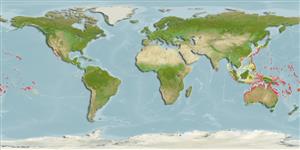Common names from other countries
>
Eupercaria/misc (Various families in series Eupercaria) >
Labridae (Wrasses) > Corinae
Etymology: Halichoeres: Greek, als, alis = salt + Greek, choiros = pig (Ref. 45335).
Environment: milieu / climate zone / depth range / distribution range
Ecologia
marinhas associadas(os) a recifes; intervalo de profundidade 4 - 15 m (Ref. 30874). Tropical
Pacific Ocean: Cocos (Ref. 9399) and Christmas (Ref. 30874) islands in the eastern Indian Ocean to the Hawaiian, Marquesan and Tuamoto islands, north to southern Japan, south to the Great Barrier Reef.
Tamanho / Peso / Idade
Maturity: Lm ? range ? - ? cm
Max length : 18.0 cm TL macho/indeterminado; (Ref. 2272)
Espinhos dorsais (total): 9; Raios dorsais moles (total): 12; Espinhos anais 3; Raios anais moles: 12. Identified by the red-striped pattern and the two ocelli in the dorsal fin in juveniles and females. Another similar species in Japan that has a spotted tail and lacks the series of white blotches over the back (Ref. 48636). Juveniles closely resemble juveniles of H. biocellatus, but have a brighter metallic sheen to the rows of light green markings along the head and back (Ref. 37816).
Inhabits lagoon and seaward reefs, coral-rich areas with sand patches (Ref. 9710). Benthopelagic (Ref. 58302). Feeds primarily on small benthic crustaceans and mollusks (Ref. 3921).
Life cycle and mating behavior
Maturidade | Reprodução | Desova | Ovos | Fecundidade | Larvas
Distinct pairing during breeding (Ref. 205).
Randall, J.E., G.R. Allen and R.C. Steene, 1990. Fishes of the Great Barrier Reef and Coral Sea. University of Hawaii Press, Honolulu, Hawaii. 506 p. (Ref. 2334)
Categoria na Lista Vermelha da IUCN (Ref. 130435)
CITES (Ref. 128078)
Not Evaluated
Ameaça para o homem
Harmless
Utilização humana
Aquário: Espécies comerciais
Mais informação
ReferênciasAquaculturaPerfil para aquaculturaEstirpesGenéticaElectrophoresesHereditariedadeDoençasProcessamentoMass conversion
Ferramentas
Relatórios especiais
Descarregue XML
Fontes da internet
Estimates based on models
Preferred temperature (Ref.
115969): 24.6 - 29.3, mean 28.2 (based on 1488 cells).
Phylogenetic diversity index (Ref.
82804): PD
50 = 0.5000 [Uniqueness, from 0.5 = low to 2.0 = high].
Bayesian length-weight: a=0.00955 (0.00451 - 0.02020), b=3.09 (2.92 - 3.26), in cm Total Length, based on LWR estimates for this Genus-body shape (Ref.
93245).
Nível Trófico (Ref.
69278): 3.5 ±0.50 se; based on food items.
Resiliência (Ref.
120179): Elevada, tempo mínimo de duplicação da população menor que 15 meses (Preliminary K or Fecundity.).
Fishing Vulnerability (Ref.
59153): Low vulnerability (10 of 100).
